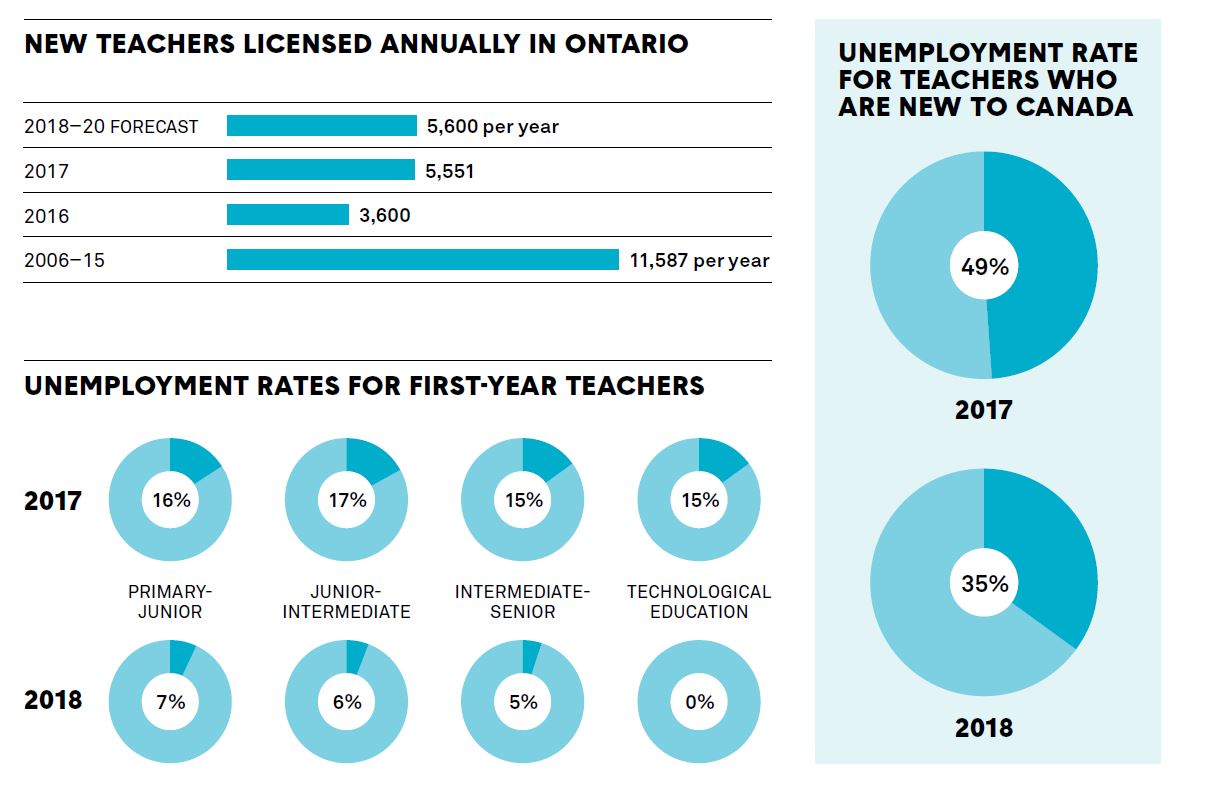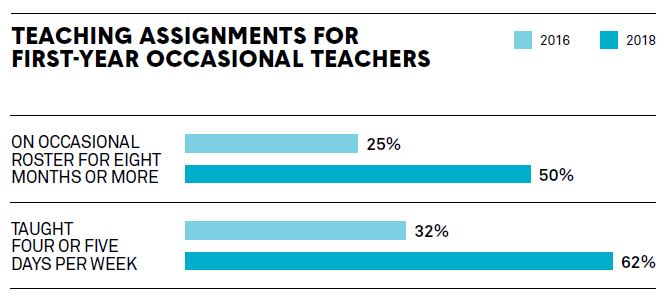Share this page
Today’s teacher candidates will enter the most promising labour market since the turn of century.
By Frank McIntyre

Ontario is emerging from a teacher surplus toward a teacher shortage. As the College’s latest Transition to Teaching survey confirms, new teachers will find jobs in Ontario more easily today than they would have 10 years ago.
The decade-long surplus of teachers that brought years of unemployment for many Ontario education graduates is nearly over. Since 2013, the unemployment rate for first-year Ontario Certified Teachers (OCTs) has dropped from 38 per cent to just six per cent in 2018. The number of unemployed OCTs in years two through five of their careers has declined from 21 per cent in 2014 to five per cent in 2018.
With record low numbers of new Ontario teachers forecast for 2018 through 2020, we can expect to see more new teachers employed over the next few years. In fact, Ontario school boards will need to prepare for teacher shortages beyond those teaching in the French school boards and French as a Second Language (FSL) teachers. English school boards will have a difficult time hiring daily occasional teachers (OTs) for their rosters. And it’s likely that we’ll see regional and subject-specific long-term occasional (LTO) and permanent vacancy shortages.
“The decade-long surplus of teachers that brought years of unemployment for many Ontario education graduates is nearly over. Since 2013, the unemployment rate for first-year OCTs has dropped from 38 per cent to just six per cent in 2018.”
Over the past two years, fewer newly licensed Ontario teachers has meant less competition for occasional teaching rosters and teaching jobs across the province. More teachers found their first jobs without having to leave Ontario. Many unemployed and underemployed teachers from earlier years also managed to find teaching jobs.
The number of unemployed teachers in the first five years after licensing is now much smaller than it was before the drop in newly licensed teachers after 2015. With more early-career teachers now employed, school boards will be looking to hire newly licensed teachers as the primary source for occasional teacher rosters and teaching jobs over the next few years. The estimated number of unemployed Ontario teacher graduates will remain much lower than in previous years — with just 1,200 in 2018, compared to 4,200 in 2016 and 7,700 in 2014.

Graduates across every division reported substantial employment gains in 2018. First-year teachers in Ontario reported unemployment rates in the mid-teens in 2017. Our 2018 survey finds unemployment dropped by more than half from the previous year’s rates with primary-junior, junior-intermediate and intermediate-senior teachers in the seven to five per cent range and no unemployment reported by first-year technological education teachers.
This year’s survey further validates the widely recognized shortage of French-language teachers in Ontario. Unemployment is now rare or non-existent among graduates of Ontario’s French-language teacher education programs and graduates of English-language programs who hold FSL qualifications.
Unemployment in Year 1 for English-language teachers fell from 19 per cent in 2017 to 9 per cent in 2018. Those qualified to teach primary-junior report 10 per cent unemployment in 2018, down from 19 per cent the year before (and 40 per cent in 2014). Junior-intermediate (JI) teachers with math or science as subject qualifications are now experiencing no unemployment, compared to 21 per cent in 2017. English-language teachers without those subject qualifications report 11 per cent unemployment, compared to 37 per cent in the previous year.
Unemployment for Intermediate-senior (IS) teachers qualified to teach math and/or science is now at six per cent, down from 11 per cent in 2017, whereas IS teachers who aren’t qualified to teach those subjects indicate an eight per cent unemployment rate, down from 23 per cent in 2017. Those who teach math and/or science continue to have an employment advantage over teachers without these subject qualifications.
Newly licensed teachers with education degrees from outside the province also made gains in 2018. Ontarians who completed teaching degrees and were licensed in other countries, and teachers educated in other Canadian provinces, found employment more easily in 2018 than in 2017. Teachers who are new to Canada with education degrees from other countries report 35 per cent unemployment in 2018, down from 49 per cent in 2017.
Despite the positive employment environment for future Ontario education graduates, many teachers who joined the profession within the last 10 years experience lingering career challenges associated with the recent teacher surplus. Career patterns are very different for French-language and English-language teachers in Ontario. The challenges are acute among English-language teachers — especially for those in Ontario district school boards.

Ontario graduates hired by French school boards find full-time employment more quickly. More than half land permanent contracts in the first year of teaching and more than four in five do so by Year 3. Similarly, nearly one in three FSL-qualified graduates teaching in English district boards have permanent contracts within Year 1, three in five by Year 3, and four in five by Year 5.
In sharp contrast, just two per cent of first-year English-language teachers who do not hold FSL qualifications have permanent contracts, and less than one in three do by Year 5. This very slow career progress is an outcome of the much greater and longer-lasting oversupply of English-language teachers over the past decade. The surplus of French-language teachers didn’t last long and was replaced by a shortage a few years ago.
A secondary contributor to the career challenges facing English-language teachers is the staged hiring process in English school boards. Teachers on occasional rosters or who hold LTO contracts must wait until a permanent vacancy arises in their own district board for which they have the qualifications and sufficient seniority to compete. Even highly experienced occasional teachers cannot apply for positions for which they are qualified outside their own boards.

Daily occasional roster teachers now report that they gain roster status much earlier in the first year following licensing than in previous years. They also receive teaching assignments for more days per week.
Many teachers moved to other provinces and other countries during Ontario’s period of teacher surplus but maintain their Ontario teaching licences.
Our surveys find the majority of these teachers hope to return to Ontario to teach in the future. In addition, many more teachers over the past decade allowed their memberships to lapse when the address they left with the College was out-of-province. Some of these individuals may well be actively teaching elsewhere and could return to Ontario to teach given the right conditions.
With low numbers of new teachers forecast over the next few years, these Ontario graduates of years past may be part of the answer to meeting recruitment needs of district school boards in the years ahead.
Transition to Teaching surveys are conducted annually. Since 2001, they have provided a longitudinal view of the changing Ontario teacher labour market.
The 2018 survey examines job-entry and professional experiences of teacher education graduates of 2008 through 2017, and new-to-Ontario teachers educated elsewhere and Ontario-certified in 2016 and 2017. Web-based surveys gathered large samples from each of these groups of early-career teachers.
Responses were received from 3,155 teachers. Response rates varied from 14 to 24 per cent of the sample groups, with an average 18 per cent return overall. The accuracy rate is 1.7 per cent overall and 2.6 to 5.4 per cent for the individual survey components, 19 times out of 20.
The annual Transition to Teaching study is made possible by a grant from the Ontario Ministry of Education. This report does not necessarily reflect the policies, views and requirements of the Ministry.
The full report is available on the College website at oct-oeeo.ca/t2t2018.